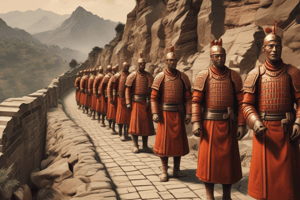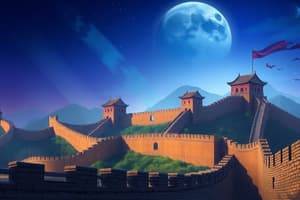Podcast
Questions and Answers
What was the primary purpose of the Great Wall of China?
What was the primary purpose of the Great Wall of China?
- To serve as a trade route
- To provide a source of employment for the Chinese people
- To protect against nomadic groups from the Eurasian Steppe (correct)
- To showcase the engineering capabilities of ancient China
Which emperor of China joined selective stretches of the Great Wall?
Which emperor of China joined selective stretches of the Great Wall?
- Qing
- Qin Shi Huang (correct)
- Ming
- Manchu
What materials were used to build the Great Wall?
What materials were used to build the Great Wall?
- Wood, stones, and mud
- Bricks, tiles, and cement
- Bamboo, mud, and straw
- Rammed earth, stones, wood, bricks, tiles, lime, and sticky rice mortar (correct)
What is the most famous stretch of the Great Wall for tourists?
What is the most famous stretch of the Great Wall for tourists?
What is the Jinshanling section of the Great Wall known for?
What is the Jinshanling section of the Great Wall known for?
What percentage of the Ming Great Wall has disappeared?
What percentage of the Ming Great Wall has disappeared?
Why is the Great Wall barely visible from low Earth orbit?
Why is the Great Wall barely visible from low Earth orbit?
What is the Great Wall of China a symbol of?
What is the Great Wall of China a symbol of?
What is the Great Wall of China's status as recognized by UNESCO?
What is the Great Wall of China's status as recognized by UNESCO?
Flashcards
Great Wall of China
Great Wall of China
A series of fortifications built along the northern borders of ancient Chinese states and Imperial China to protect against nomadic groups.
Great Wall Construction
Great Wall Construction
Qin Shi Huang selectively joined previously built walls, while the Ming dynasty constructed the best-known sections.
Great Wall Features
Great Wall Features
Watchtowers, troop barracks, signaling capabilities, and transportation corridors.
Great Wall Length
Great Wall Length
Signup and view all the flashcards
Ming Dynasty Construction
Ming Dynasty Construction
Signup and view all the flashcards
Defense Against Manchus
Defense Against Manchus
Signup and view all the flashcards
Great Wall Composition
Great Wall Composition
Signup and view all the flashcards
Great Wall Condition
Great Wall Condition
Signup and view all the flashcards
Visibility from the Moon
Visibility from the Moon
Signup and view all the flashcards
Study Notes
The Great Wall of China is a series of fortifications built along the northern borders of ancient Chinese states and Imperial China to protect against nomadic groups from the Eurasian Steppe. Walls were built from as early as the 7th century BC, with selective stretches later joined by Qin Shi Huang, the first emperor of China. The best-known sections of the wall were built by the Ming dynasty. The defensive characteristics of the Great Wall were enhanced by the construction of watchtowers, troop barracks, garrison stations, signaling capabilities, and transportation corridors. The wall stretched from Liaodong in the east to Lop Lake in the west, from the present-day Sino–Russian border in the north to Tao River in the south, spanning a total length of 21,196.18 km. The wall had various names in Chinese and English, with "Long Wall" and "Ten-Thousand Mile Long Wall" being some of them. The Ming construction was stronger and more elaborate due to the use of bricks and stone instead of rammed earth, and up to 25,000 watchtowers were estimated to have been constructed on the wall. The Great Wall helped defend the empire against the Manchu invasions that began around 1600, and the Manchus were finally able to cross the Great Wall in 1644. The Willow Palisade was constructed by the Qing rulers in Manchuria to prevent Han Chinese migration into Manchuria. European accounts of the Great Wall started to circulate in Europe soon after Europeans reached Ming China by ship in the early 16th century, even though no European was to see it for another century. The full course of the Great Wall is difficult to describe in its entirety, but in 2012, the National Cultural Heritage Administration of China concluded that the remaining Great Wall associated sites include 10,051 wall sections, 1,764 ramparts or trenches, 29,510 individual buildings, and 2,211 fortifications or passes, with the walls and trenches spanning a total length of 21,196.18 km.The Great Wall of China: History, Characteristics, and Condition
- The Great Wall of China measures 8,850 km in total, consisting of 6,259 km of wall sections, 359 km of trenches, and 2,232 km of natural defensive barriers.
- The wall was built during different dynasties, with the Ming Great Wall being the most famous and visited by tourists.
- The Badaling Great Wall near Zhangjiakou is the most famous stretch of the wall, while the Jinshanling section is known for climbing extremely steep slopes.
- The wall was built from rammed earth, stones, wood, bricks, tiles, lime, and sticky rice mortar.
- Battlements, defensive gaps, signal towers, wooden gates, barracks, stables, and armories were built along the wall.
- The wall is in disrepair in many locations, with graffiti, vandalism, and destruction for construction or mining purposes.
- 22% of the Ming Great Wall has disappeared, while 1,961 km of wall have vanished, and more is expected to disappear due to erosion from sandstorms.
- The Great Wall cannot be seen by the naked human eye from the Moon, but it is barely visible from low Earth orbit (160 to 320 km).
- The Great Wall was mentioned in popular culture and believed to be visible from the Moon due to a myth that started in the 18th century.
- NASA claims that the wall is no more conspicuous than many other human-made objects from low Earth orbit.
- The Great Wall of China is a UNESCO World Heritage Site and one of the Seven Wonders of the Medieval World.
- The wall is a symbol of Chinese civilization, engineering, and defense against invasions.
Studying That Suits You
Use AI to generate personalized quizzes and flashcards to suit your learning preferences.




